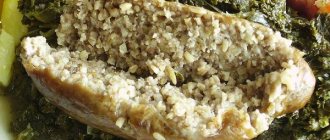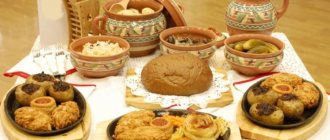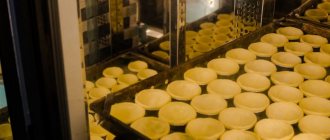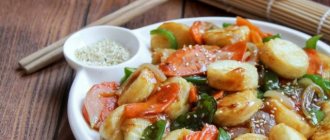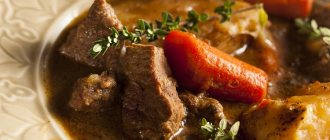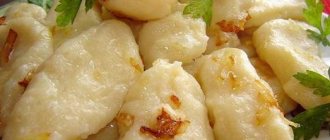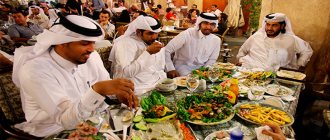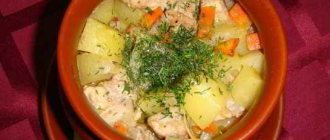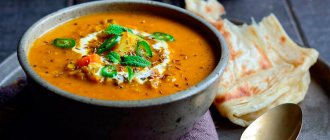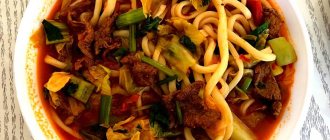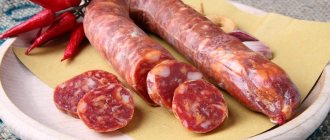Belarusian cuisine
Belarusian national cuisine has existed for many centuries. It was formed under the influence of historical events in Belarus, geographical location and weather conditions. Settlers from border areas added variety to the recipe. Active farming contributed to the use of a variety of local products in the preparation of national dishes
.
History of Belarusian cuisine
Since the time of the Grand Duchy of Lithuania, recipes from the cuisines of other nations - Baltic, Jewish, German - have appeared in Belarusian cuisine. For many centuries, meat was not included in the diet of Belarusians in large quantities. The place of meat was taken, as in Ukrainian cuisine, by lard. It was salted directly with the skin. Mushrooms, which at that time were not pickled, but dried, also served as a substitute for meat dishes.
In Belarusian cuisine, unlike other national cuisines, dairy and sweet products were practically not consumed. Instead of sweets, drinks like jelly or butter pies were served for dessert.
Subsequently, Belarusians began to use more meat in their diet. Usually meat dishes were prepared for holidays. The most popular types were pork, beef, poultry, and game. To this day, the national recipe includes such dishes as machanka, verashchaka, smazhanka, homemade sausages, and salted lard.
Belarusians also actively used river fish in folk recipes. The most popular were pike, sturgeon, bream, eel, carp, perch, and pike perch. They made soup and dumplings from the fish.
The country cuisine was hearty, simple and always fresh. Most dishes were served hot. Princely and noble dishes were more varied and exotic. On magnate tables there were often stuffed pike perch and various delicacies.
During Soviet times, Belarusian cuisine was influenced by recipes from other nations. Ukrainian and Caucasian cuisines appeared in public catering places.
In the twentieth century, various dishes made from wheat flour were added to Belarusian recipes and numerous salads appeared.
Modern Belarusian cuisine
Recipes today hardly use the same products that our ancestors used. Some vegetables and legumes disappeared from our table. But many dishes have been preserved to this day: pancakes, dumplings, pickles, kvass or beetroot soups, homemade sausages, lard, meat dishes.
Many national dishes include potatoes. The average Belarusian eats about half a kilogram of potatoes every day. Potato recipes include potato pancakes, casseroles, babka, fried and stewed potatoes.
People in Belarus eat half as much meat as in neighboring Poland. The most popular type of meat is pork.
Among the popular national meat dishes:
- bigos – stewed cabbage with meat;
- sorcerers - potato pancakes with meat;
- machanka - usually a dish of various cuts of meat in the form of a sauce, served with pancakes;
- smazhanka - meat pie.
Popular modern soups of home-made Belarusian cuisine include ukha, borscht, mushroom and pea soup.
As for alcoholic drinks, Belarusian liqueurs based on vodka, honey, and cranberries have been preserved under various names (zubrovka, krambambula, etc.). Kvass and birch sap are very popular.
Belarusian sweet dishes
Honey has always been very popular in Belarusian home cooking. Belarusians love pancakes with honey, honey porridge, and pies. Since ancient times, malt (dough), jelly, and baked apples have been prepared with honey.
Gingerbread is a sweet flour dish that came to us a long time ago and was called “perniki” in the Belarusian language. It is believed that the name of this delicacy originates from pagan times, when the sun god Perun was worshiped. People made sacrifices to the gods, and it was then that it became customary to sculpt animal figures from sweet and tasty dough. Then not only the name of the sweet dessert changed, but also the taste, as gingerbread began to be baked from wheat flour, and not from rye.
Pancakes
Historians still argue about how this dish originated. There are several different versions. Some believe that pancakes began to be baked using rye jelly. Others say that the word “pancake” comes from the word “mlyn” (mill). Previously, pancakes were baked from various types of flour, but now pancakes are baked mainly from wheat flour based on yeast, milk, sour cream or kefir. Pancakes are usually eaten with a variety of fillings, jam or honey.
Belarusian restaurants
You can still try ancient national recipes today in various restaurants of Belarusian cuisine, where guests of our country come with pleasure. Not only village dishes will be served here, but also delicacies that the gentry and Belarusian nobility feasted on.
In common agricultural estates in Belarus and ethnographic Belarusian complexes, you can try dishes prepared according to unique recipes characteristic of these regions. Moreover, in most cases, you will be served food from fresh products grown and collected right on site. This includes freshly baked bread, meat sausages, homemade cheeses, and sweet desserts made from fruits and honey. Dishes prepared according to ancient recipes can be tasted during an excursion to the Dudutki Museum of Ancient Crafts, which you can book directly on our website.
On the menu of modern Belarusian restaurants you can find dishes not only of Belarusian, but also of Caucasian, Eastern, and Western European cuisine.
However, tourists who come to our country should definitely try dishes of Belarusian cuisine, such as potato pancakes, borscht, machanka, sauerkraut, pickled cucumbers, lard and national liqueurs.
National cuisine of Belarus: we’ll tell you not only about potatoes.
National Belarusian cuisine is primarily associated with such dishes as pancakes, babka and sorcerers. However, Belarusians are not satisfied with potatoes alone, and this is not the only product in their diet.
Belarusian cuisine arose under the influence of its Slavic neighbors (Ukrainians, Russians, Poles), on the one hand, and on the other hand, it was strongly influenced by the cuisine of non-Slavic peoples - Latvians and Lithuanians. Due to class differences, closely intertwined with national and religious ones, for a long time there was a difference between the cuisine of ordinary peasants and the cuisine of magnates, nobles and nobles. The gastronomy of the urban, rural and small-town populations also differed.
But still, by the end of the 19th century, the Belarusian national cuisine still acquired its originality and uniqueness. The most typical products for it are apples, pears, cabbage, peas, beans, turnips, carrots, rutabaga, mushrooms and wild berries. And of course, potatoes, which have a special place. Meat - pork, river fish. Wheat flour became widespread only in Soviet times; before that, oatmeal, rye, barley, buckwheat and pea flour were actively used. Bread was baked only from rye flour, and oatmeal was used to prepare other flour products.
The main characteristic feature of the traditional national Belarusian dish is not its composition, but the cooking process itself. This includes the widespread use of such heat treatment methods as simmering, stewing and baking. And bringing the dish to a semi-thick consistency. And cooking and then serving the dish in earthenware.
TOP 10 traditional Belarusian dishes
Father
Tops, in particular beet tops, were a very popular edible ingredient among peasants, who pickled and fermented them in large quantities. Fresh leaves were put into young beet soup in spring and summer, canned leaves were used in winter. Batsvinnik was cooked in both meat and vegetable broths, eggs and dill were added, thickened with flour and seasoned with sour cream when serving.
Interesting fact: for the great love for this dish in the 17th and 18th centuries. Lithuanians received the nickname “fathers”.
Gryzhanka
A dish based on rutabaga, which was cut into cubes, stewed in water, and then seasoned with milk. On special occasions, meat was added instead of milk. Basically, the hernia was cooked in winter, and it was an important source of vitamin C, which is practically not destroyed in rutabaga during cooking.
Krupenya
It is something between soup and porridge. The main component is barley or rye grits, seasoned with pork and boiled to a jelly state. Then boiled vegetables with a thick broth, mushrooms and fresh herbs are added to the dish.
Veraschak
A type of machanka made from pork ribs and sausage, into which bread, pancakes or boiled vegetables are dipped. In the old days it was a festive treat served at weddings, Komoeditsa and Shchedrets.
The history of the dish's origin is interesting. The author of the recipe is the royal cook Vereshchak, who once boiled sausage in light beer and served it with onion sauce. The king liked this method of serving and soon gained fame, going beyond the walls of the palace. This dish was supposed to be eaten with a spoon, but Belarusians were more accustomed to dipping it into it rather than pouring it on it, so they began to do the same with verashchaka. In addition, not everyone had the necessary products and light beer on their household, so over time the recipe changed, and the dish began to be prepared from kvass, lard, ribs and brisket.
Zhur
This dish is one of the oldest soups in Belarusian cuisine. Traditionally, it is made from zest (a fermented, strained solution of oatmeal or rye flour), which is mixed with broth, water or milk. Then separately cooked vegetables are added to the soup.
Knysh
It is a small round pie with a filling of buckwheat porridge or fried onions with cracklings baked inside. In the 19th century in moderately wealthy homes it was served as an addition to meat dishes.
Traditionally, knishes were prepared for holidays and funeral evenings, and they were also treated to carolers and midwives.
Kulaga Belarusian
A kind of dessert delicacy that was once very popular. When preparing kulaga, rye flour was mixed with wild berries and a small amount of honey. The resulting mass was lightly baked in the oven and consumed chilled.
Coma
Balls of pea puree with cracklings, onions or cabbage, fried in oil. This is a ritual dish that was served on Komoeditsa - a holiday dedicated to welcoming spring and awakening the bear from hibernation. In Rus', pancakes were baked as a treat for bears, and in Belarus, comas became a ritual delicacy for these animals, in addition to dried turnips and oatmeal jelly.
Perniki
Yes, yes, the well-known gingerbreads came to Belarusian cuisine from pagan times, when our ancestors worshiped several gods. Among them was the god of thunder and lightning - Perun. Initially, ancient people, in order to appease the formidable deity, sacrificed animals, mainly bulls, to him. However, over time, they were replaced with figurines made of sweet dough, calling them after the revered god.
Perniks were prepared from rye flour, honey and fresh berries, mixing them in arbitrary proportions so that the dough could be sculpted like plasticine. The dish was baked on leaves in the oven.
With the advent of Christianity, the tradition faded into oblivion, and gingerbread became a common sweet treat for children and adults.
And now we can talk about potatoes. By the way, this product was brought to Belarus in the 18th century. and quickly became popular along with bread. Belarusian potatoes are special and starchy, so we have a couple of dozen original dishes that are difficult to reproduce outside the country.
Pyzy
To prepare these koloboks with a slightly strange name, a dough of flour, potatoes and cottage cheese is kneaded. A filling of minced meat and onions is placed inside. Then fried in oil. Served with mushroom or sour cream sauce.
This, of course, is not a complete list of our national dishes, and if we list them all, there simply won’t be enough space in one article. Therefore, we settled on the most interesting and original ones.
text: Karna Kruchina
If you find an error, please select a piece of text and press Ctrl+Enter.
Baked potatoes with mushrooms and bacon
What are the dishes of Belarusian national cuisine called? Their names are very simple and understandable to everyone. As a rule, they are similar to Russian dishes, but may sound slightly different (zhur, ukha, dumplings, potato pancakes, drachena, sorcerers, kindyuk, machanka, zrazy, knuckle, etc.).
So how to prepare national Belarusian potato dishes? For this we need:
- potatoes - 1 kg;
- smoked bacon - about 300 g;
- dried porcini mushrooms - approximately 100 g;
- refined oil - 30 ml;
- sea salt, dried rosemary, black pepper, sweet paprika - use to taste.
We process the components for the bigus
The dishes of the Belarusian national cuisine, the recipes of which we review, always turn out not only tasty, but also very satisfying and high in calories. Before preparing bigus, it is necessary to process all components. The pork is washed, dried and cut into cubes. The onion is peeled and chopped into half rings. The carrots are peeled and grated on a large grater. The cabbage is stripped of its surface leaves and cut into thin strips. Smoked meats are chopped into small pieces, and seedless prunes are steamed in boiling water and then chopped with a knife.
National food
Very often different types of flour are used in the cuisine of Belarus, in addition to grain crops, buckwheat, oatmeal or pea; they are often mixed with each other. In this case, the dough is kneaded without yeast, although yeast methods have prevailed recently; various ingredients are added to it. Traditional dishes include thin flatbreads “perepecha”, “draniki”, which are made from potatoes and flour, filled pies, specific pancakes made from several types of flour, filled dumplings, and pea pancakes. Absolutely unusual dumplings “daws”, in the dough of which minced meat, cottage cheese, vegetable puree, etc. are mixed, “malt” - this dish is prepared from dough that is heated and cooled several times, as well as a variety of flour bases for more complex dishes.
Of all the vegetables, the most common are potatoes, legumes, especially peas, carrots, cabbage and all kinds of mushrooms, which are stewed, boiled or prepared in powder form. There are a lot of vegetable dishes, and some of them, despite their Slavic basis, are somewhat unique and practically unlike any other dish. Worthy of attention are the soup “zhur”, prepared from oat broth and very similar to jelly, the cold soup “kholodnik”, the famous “zrazy”, “kopytki”, “kartoflyanki”, “kolduny”, “tsybriki” and “tushanka”.
Local traditional dishes include the following: scrambled eggs, mashed potatoes baked with various ingredients - “gulbishnik”, “cabbage” soup, “polivka” - a soup made from vegetables and cereals, eggs stuffed with mushrooms. This also includes soups made from carrots, pumpkin, rutabaga and cabbage soup with buckwheat porridge or mushrooms, as well as radish fried in honey.
Until the beginning of the last century, the Belarusian table was not particularly rich in meat, which was mainly used as an ingredient for various holiday dishes, as well as for preparing preserves and pickles. But these days in Belarus many dishes are prepared from pork, lamb, lard, beef, goose and chicken meat, as well as various offal. Homemade sausages are especially worthy of attention because their quality and taste are excellent, for example, blood sausage, for which boar meat is often used, then loin or lightly smoked ham, a sausage made from lard, meat and porridge called “yuts” or “stravnik” . Another type is “pyachisto” - these are large pieces of meat that are baked, stewed or fried with fruits and vegetables, smoked and salted pork meat and lard, “bigos” - meat stewed with spices and vegetables, a liver dish - “vantrobyanka” " A dish that will surprise you with its taste is “greased” - this is poultry or game meat that is baked for a long time in a large amount of fat, as well as “machanka” - this is a dish of sausage and meat with bones fried in meat sauce. Also on Belarusian tables, dishes that are quite common are borscht, broths with flour products, or meat fried in deep dishes. For frying, lard, ghee or vegetable oil, sour cream are often used, and greens and onions are almost always added.
The extensive lake and river network of this country supplies a large amount of crayfish and fish to the local table. Fish dishes in the kitchen are quite simple and consist mainly of boiled, fried or baked fish products, various types of fish soup, minced fish, which goes into some dough products, and in some areas the fish is dried or added to complex dishes.
Belarusian cuisine has a characteristic feature that distinguishes it from other Slavic relatives, so it is the almost absolute absence of dairy dishes on the table. But this does not mean at all that milk is not used at all; the fact is that milk components are not served on the table in their pure form, but are used as irreplaceable ingredients for more complex dishes. Dairy products that are used in Belarusian cuisine include cottage cheese, yogurt, butter, whey, cheese and sour cream; they are used as mandatory additives to some dishes, which, if necessary, can whiten them. Whey and milk are used to make a variety of soups with vegetables and dumplings, as well as desserts and cereals. “Mokanka” occupies a special place because it is an independent dish made from sour cream, cottage cheese, milk and buttermilk, which is used as a cold appetizer or as a gravy for pancakes.
Belarusian cuisine also includes a lot of sweets. Desserts are usually drinks, for example, kvass, which can also be fruity, as well as “malt,” a kind of jelly made from berries, sugar, flour and honey - kulaga, baked apples, as well as fresh fruits and berries. Special attention should be paid to the large round pie filled with apple jam, dates and raisins, which is called “dzyad”.
LiveInternetLiveInternet
Quote from Alex_Prime
Read in full In your quotation book or community!
Belarusian cuisine.
Top 5 potato dishes. One of the most characteristic features of Belarusian national cuisine is the widespread use of potatoes, which are called second bread. It is rare to find a dish in which potatoes are not used in one form or another. Potatoes are used to prepare independent dishes and are also used as a side dish.
Belarusians especially love traditional potato pancakes.
Let's start with them. Draniki
The most authentic Belarusian dish. Some people call them potato pancakes and think that they are very easy to prepare. But that's not true. One wrong move and the pancakes will turn out gray and sticky. Ingredients:
Potatoes – 5-7 pcs.
or 500-700 g Onions - 1/2-1 pcs. or 100-150 g Egg - 1 pc. Flour - 2 tbsp. with a slide Vegetable oil Salt Ground black pepper Preparation:
Peel the potatoes, grate them on a fine grater. For simplicity, some people prefer to grind the potatoes in a blender or grind them through a meat grinder... They say that then the potato pancakes can turn out tough. I didn’t notice much of a difference, but I always grate it, if only because it’s easier for me to wash than a blender or meat grinder))) You can even grate the potatoes on a coarse grater if you’re really hungry) Peel the onion and grate it on a fine grater. It is advisable to quickly add the onion to the potatoes so that they do not start to darken. If there is a large quantity, I rub one at a time - three potatoes, then an onion, etc. Also, to prevent the potatoes from darkening, you can add a spoonful of kefir or sour cream. Add egg, salt, ground black pepper, and flour to the potato-onion mixture. You can add a little soda for splendor. Mix the dough until smooth. Pour vegetable oil into a hot frying pan, spoon out the potato mixture in the form of small pancakes.
Fry the pancakes on both sides over medium heat until golden brown. Reduce heat, cover the pan with a lid and simmer for another couple of minutes. Draniki are served mainly with sour cream, but I also recommend frying: lard cut into small cubes (preferably with layers of meat) and onion, cut into rings, fried together with lard.
Sorcerers
These are Belarusian pancakes with filling (usually meat or mushroom). Sometimes they make sorcerers with cabbage and carrots, pumpkin, beans, pea puree, lentils, cheese - that is, with whatever goes well with the taste of potato pancakes. Even ordinary fried onions found inside such a potato pie pleasantly diversify its taste. The sorcerers consist of three layers: potatoes on top and bottom, and filling in the middle (in our case, minced meat). Ingredients:
Potatoes – 6-8 pcs.
or 600-800 g Onions - 1 pc. or 150 g Minced meat (pork, pork-beef or chicken) - 300 g Egg - 2 pcs. Flour - 1-2 tablespoons Salt Ground black pepper Preparation:
Let's start with the filling. If the minced meat is already prepared, peel the onion and grate it on a coarse grater (if you have meat, you know what to do). Pepper and salt. Mix everything well, cover and refrigerate (let the minced meat soak in the spices while you prepare the potato dough). If the minced meat turns out to be liquid, you can add a little semolina to it, it will absorb excess moisture. Let's make the dough. Peel the potatoes and grate them on a fine grater. Squeeze lightly and drain the resulting juice. Add eggs, flour. Stir and add salt. Unlike simple potato pancakes, we don’t put onions in the dough; onions are in the minced meat! Let's fry. Heat the oil in a frying pan (oil layer - 1 cm). Place the potato dough in hot oil (1-2 tablespoons for each potato pancake). Flatten the flatbreads in a frying pan so that they do not lie in a heap. Make small flat cakes from the minced meat, slightly smaller in size than potato pancakes in a frying pan. Place a meat patty on each pancake (also level). Place a layer of potato dough on top of the minced meat (a little less than you used for the base, 1 tablespoon) and press down a little. Fry over low heat for three minutes. Turn over. Cover with a lid and fry over low heat for 5-6 minutes. Ready!
After all the sorcerers are fried, you can put them in a frying pan, add a little water, cover with a lid and simmer for five minutes. But I usually don’t have enough patience for this)))
Pyzy
Delicious balls made from unusual dough with meat filling! We love this dish just as people in Russia love dumplings, and they prepare pyzy both for holidays and on weekdays. This is a very tasty and satisfying dish, made from available products, does not take much time, is not difficult to prepare - even a novice housewife can easily make pyzy. Ingredients:
Cottage cheese - 1 pack or 250 g (you can take homemade, it will only taste better!) Flour - 1 tbsp.
Starch – 1 tbsp. Potatoes – 3-4 pcs. or 300-400 g salt Filling: Minced meat - 500 g (pork + beef + onion, salt, egg, spices - the same as for dumplings) Preparation:
Mix cottage cheese, starch, finely grated potatoes, flour and salt - it turns out very dense dough. No water or eggs are added to the dough, and yet it never falls apart or breaks. If the dough does not stick together into one lump, it means there is not enough moisture and you need to add a little more grated potatoes.
Then we begin to cut this dough in the same way as dumplings - we roll sausages, cut them into pieces and roll them out like dumplings, only thick ones - 5-6 mm. The dough is very easy to work with, it is plastic and does not stick to your hands.
Then the most interesting thing: we begin to sculpt pyzy. Place the minced meat on the flatbread and pinch it into a knot, forming a ball. The result is cute koloboks - pyzy, in size - something between dumplings and dumplings.
There are 30-35 of these beauties. Once molded, heat generously poured vegetable oil in a frying pan (ideally, you can probably do it with cracklings) and begin to fry the pyzy until golden brown on both sides.
I already want to eat them, but it’s too early: put the fried pyzy tightly in a saucepan, add a little salt, bay leaf, allspice, coriander - whoever likes what, and pour hot boiled water so that the pyzy are just covered, but didn't swim!
Simmer the pyzy over low heat for 20-25 minutes until the minced meat is cooked. During this time, the broth is almost absorbed, and the pyzy become juicy, tender and very tasty! They are eaten hot, with sour cream - just delicious!
Tarkovans
These are potato cutlets with minced meat. They were christened Tarkovans from the method of grating potatoes and obtaining potato mass - it is called tarkovana (raw grated potatoes, after grating, not strained, but used together with the released juice). Ingredients:
Potatoes - 5 pcs.
or 500 g Minced meat 600-650 g Onions – 1-2 pcs. or 100-200 g Chicken egg - 1 pc. Carrots - 1 pc. Bell pepper - 1 pc. Tomatoes - 2 pcs. Cream – 0.5 liters (or sour cream) Garlic – 1 clove Flour – 2 tbsp. l. Salt, spices to taste Vegetable oil Preparation:
Grate the potatoes on a coarse(!) grater, then combine with minced meat. Then beat a chicken egg into the potato-meat mixture, add salt, add spices and mix well. Make plump cutlets from the resulting minced meat, then roll in flour and fry over high heat until golden brown. Cut the garlic into slices, bell pepper into strips, carrot into circles, onion into rings. Place the cutlets in a cauldron or saucepan, place chopped vegetables on top, pour cream (or sour cream). Add salt to taste and put on fire to simmer. Simmer vegetables and cutlets until cooked.
Serve with vegetables; sour cream or tomato sauce can be served separately.
Potato babka
In Belarus, potato babka is one of the favorite national dishes. It seems like a simple set of ingredients (potatoes, onions and fresh lard with a layer of meat), but the aroma from the dish in the house is wonderful! What can we say about the taste! Especially if you cook potato babka in a pot... Yummy - beyond words! Be sure to try it! Ingredients (for 2 half-liter pots):
Potatoes – 800 g-1 kg Brisket with meat layer – 250 g Mushrooms – 200 g (preferably, of course, forest ones) Onions – 150 g Sour cream – 2 tbsp.
l. Flour – 1 tbsp. l. Egg – 1 pc. Salt and ground black pepper to taste. Preparation:
Cut the brisket into small cubes and fry for several minutes, then add chopped onion to it and bring it to a golden color. After a few minutes, add the mushrooms and saute everything together until done. Finally season with salt and pepper. Then cool. Peel the potatoes last (before adding, so as not to darken, and grate them on a fine grater (do not drain the liquid!). Combine the grated potatoes with sour cream, egg, flour and salt. Mix everything well. To make the babka more flavorful, you can add garlic clove small clove of garlic. Add the fry to the potato mixture, place in pots greased inside and place in the oven. If you are cooking in a ceramic dish, the oven should be initially cold and you will preheat it to 200 degrees. If the dish is metal, place in an already preheated one oven to 200 degrees. Cook for 45-60 minutes. Then remove the lids, and another 15 minutes to get the most amazing golden brown crust)))
These are the simple but incredibly appetizing dishes in Belarus. That's not all, to be continued...
BELARUSIAN CUISINE
The uniqueness of the historical destinies of the Belarusian people had a profound influence on the formation and development of their culture. Deprived of their national statehood before October 1917, having experienced the cross-influence of the Orthodox, Uniate and Catholic churches, the Belarusian people, in difficult and contradictory conditions, were forced to defend their national characteristics and customs, including material culture, which includes national cuisine.
Under these conditions, Belarusian cuisine, on the one hand, continued to remain close to the cuisines of the Slavic peoples surrounding Belarusians - Russians, Ukrainians, Poles, and on the other hand, experienced a certain influence from the cuisines of their non-Slavic neighbors - Lithuanians and Latvians. In addition, culinary art in the eastern and western parts of Belarus, isolated from each other for a long time, developed differently and was subject to different influences. All this prevented the consolidation of the already established specific features of Belarusian cuisine and hampered the development of national culinary techniques and individual dishes characteristic only of Belarusian cuisine.
Class differences, which were closely intertwined with national and religious differences, especially hindered the formation of a single national cuisine. While the peasantry was Belarusian and Orthodox, the gentry was Belarusian, but predominantly Uniate, the privileged nobility was Polish and Lithuanian in national terms, and exclusively Catholic in religious terms. Hence, naturally, a difference arose not only between the cuisines of the rural, small-town and urban population, but also between the “magnate”, “lord’s”, “gentry”, “gentry” cuisines and the cuisine of the common people. The cuisine of the ruling classes and the gentry following them was strongly influenced by Wielkopolska and partly German cuisine, while the cuisine of the burghers, artisans and all small-town people was influenced by the tavern cuisine of the Jews, whose mass migration to Belarus began in the 17th century .
Peasant Belarusian cuisine until the end of the 19th and beginning of the 20th centuries steadfastly retained its original features, rooted in the 13th-14th centuries and sometimes even deeper - in the ancient Russian cuisine of the Krivichi and Dregovichi.
At the same time, regional differences were quite noticeable in peasant cuisine. Thus, the cuisine of the peasants of the Vitebsk and Mogilev regions differed from the cuisine of the Western Belarusians of the Grodno region, and both of them, in turn, differed from the cuisine of the Poleschuks, or Pinchuks - residents of Polesie, less affected by foreign influences.
It is remarkable, however, that, despite all the contradictions, Belarusian cuisine still gained its independence by the end of the 19th century.
The basis of modern Belarusian cuisine thus became the cuisine of the rural population of the eastern and western regions, which included the most common and long-existing dishes of the urban population on the territory of Belarus, which developed mainly under the influence of Polish cuisine, but received Belarusian processing. As a result, Belarusian cuisine has its own circle of predominantly used, favorite products and its own special methods of cooking, preliminary and thermal processing of food raw materials. This led to the selection of such dishes in Belarusian cuisine, which in their entirety are not found among the peoples neighboring Belarusians, although the principles of preparing individual dishes of Belarusian cuisine are not at all alien to Russians, Ukrainians, Poles, or Lithuanians.
However, the similarity of the food products used by these three cuisines, as well as the common type of hearth (Russian oven in which dishes of Belarusian cuisine were created), at a superficial glance, gave the impression that Belarusian cuisine is one of the branches of all-Russian cuisine.
However, this is far from the case. Let's take, for example, the products most often used in Belarusian cuisine. First of all, these are various types of “black flour” - oatmeal, rye, barley, buckwheat and pea, and in Belarus rye flour was used for bread, and oatmeal for all other flour products.
The predominant use of oatmeal in the past and ignorance of yeast led to the fact that Belarusian cuisine practically does not know either pancakes or pies - this was hampered by the properties of oatmeal (as well as its preparation and processing by self-fermentation, which is common in Belarus). That is why Belarusian “pancakes”, the so-called raschinnaya, made from oatmeal, are completely different from Russian ones; they are made directly from raschin, i.e. a solution of flour and water, spontaneously sour. Pies were not typical of Belarusian cuisine in any form at all.
Another feature of the use of flour is the very frequent mixing of its various types, admixing other types of flour (rye, oatmeal) with any main type of flour - barley, buckwheat or wheat, pea.
Of course, during the years of Soviet power in Belarus, as well as throughout the country, the use of wheat flour became widespread (and along with it came other products that were previously not typical of Belarusian cuisine), but there they began to most often prepare products from wheat flour without yeast, using baking soda as a baking powder.
Of the vegetables, the most typical for Belarusian cuisine are cabbage, peas, carrots and, of course, potatoes - the latter has a special place.
Indeed, it is characteristic of Belarusian cuisine not only that it knows about two and a half dozen potato dishes, each of which is different from the other, but also that these dishes are firmly entrenched in the menu and form an indispensable, essential part of the national table. This is explained by historical reasons - the penetration of potatoes into Belarus approximately 75-90 years earlier than into Russia, as well as natural and climatic conditions that facilitated the breeding and development of highly starchy tasty
potato varieties. That is why sometimes purely Belarusian potato dishes do not turn out as tasty outside the republic if watery, low-starch potato varieties are used for their preparation.
The natural and geographical conditions of Belarus contributed to the widespread use of such products as mushrooms, wild berries and herbs (wort, sorrel), apples, pears, river fish, crayfish, milk, cottage cheese, sour cream. These products are also typical for Russian national cuisine, but the forms and methods of their use in Belarusian cuisine are somewhat different.
For example, mushrooms are only boiled and stewed, but Belarusian cuisine does not know dishes made from fried mushrooms (just as it did not know how to marinate and pickle mushrooms until the beginning of the 20th century). In general, mushrooms are not consumed as a completely independent dish, but are always used as an additive - a “coloring” that adds flavor to some main dish. Therefore, Belarusian cuisine uses not only and not so much the mushrooms themselves, but dried mushroom powder, which is poured into the yushka and into the second stewed vegetable or meat dish. They also do not fry the fish, but either bake it whole with scales, or dry it in a special way after lightly frying, or use it as minced meat, adding it to dumplings, jackdaws, etc.
As for dairy dishes, again, there are no purely dairy dishes in Belarusian cuisine, but a variety of milk derivatives (cottage cheese, sour cream, whey, butter) are used as mandatory additives - “whites”, “zakras” and “vologs” - in many dishes that contain flour, potatoes, vegetables or mushrooms.
Wild berries, pears, and apples do not go together. Dishes made from them - kulagi, jelly, kvass, mashed potatoes, casseroles - are prepared from only one type of berry or fruit.
Eating and cooking meat in Belarusian cuisine also has a number of features. The consumption of lard and pork makes Belarusian cuisine similar to Ukrainian. However, lard in Belarus is eaten almost exclusively in winter, lightly salted, always with a skin layer. They eat it with potatoes, as a bite, it kind of plays the role of meat. But for the preparation of most dishes, in addition to lard and even more often, sour cream, ghee and vegetable oils are used as fat - formerly hemp, now sunflower. Pork is used as meat mainly for the preparation of homemade sausages and vandlina - lightly smoked ham or brisket. Lean pork, as well as lamb, is baked in large pieces (usually the entire back part) - the national Belarusian dish pyachisty
. Among poultry they prefer goose, also baked.
Old Belarusian cuisine is also characterized by salting meat and poultry (geese) - preparing corned beef and strips from them - and eating offal, especially dishes from the stomach and udder in boiled form.
Already this cursory list of the main food raw materials and their use allows us to notice that the favorite culinary methods of heat treatment in Belarus are baking, boiling, simmering, and stewing. To this should be added two seemingly diametrically opposed methods of pre-processing products: either the use of large, indivisible masses - baking a whole leg (ham), a whole stomach, a whole goose, a whole fish - or, conversely, chopping, crushing, grinding the product, etc. .e. transforming it even before heat treatment into chopped mass, minced meat, puree, powder - regardless of whether it is meat, vegetables or mushrooms. The first method comes from ancient times, the second is characteristic of later times, borrowed from Polish cuisine, but it is this method that has received the greatest development.
The use of minced and puree-shaped masses from one particular product (meat, fish, potatoes) and especially from combinations of the main product with small admixtures of some others gave the majority of potato dishes in Belarusian cuisine (pancakes, tsibriki, gulbishniki, etc.), many meat ones (flyaki, mokanina, vantrobki, sausages), as well as a number of combined ones (dumplings, jackdaws, zrazy), which have become widespread outside of Belarus.
Along with chopping, in Belarusian cuisine it is also common to boil food, which involves prolonged cooking, prolonged steaming and simmering of products, which in the end should form a thick, mushy dish. There is even a known method of artificially thickening a dish, when flour and starch are added to it - the so-called pinned.
The boiled, shapeless nature of a dish was recognized as an ideal in ancient Belarusian cuisine; it determined the simultaneous placement of all the components of the dish into a dish (pot, cast iron) and filling them with water almost to the top of the dish. In this case, liquid leakage was prevented by the fact that the heat used for heating was gradually reduced, rather than increased, and thus the dish was boiled very slowly, gradually, sometimes over the course of a whole day. Since such a thermal regime can only be achieved in a Russian oven, modern Belarusian cuisine, using new sources of heating - with rising rather than falling temperatures - has abandoned some traditional dishes of the past, in particular thickened soups with slaughter. The need for them has also disappeared because now it is possible to cook first and second courses at the same time, without resorting to artificially thickening soups with heavy flour fillers. That's why we don't serve outdated slaughtered soups. But it is still necessary to mention them, because the tradition that developed in the past in Belarusian cuisine of preparing one common dish, which has the qualities of both the second and the first at the same time, left its mark on many culinary techniques and culinary terminology of Belarusians that have survived to this day. In particular, the division of products into groups depending on the role they play in dishes is firmly established. These are welding, painting, pinning, vologa and prismaki.
Weldings
- these are the main products that form the basis of the dish in quantity, in their decisive role in it and often give the name to the entire dish. Their role is usually played by vegetables such as cabbage, rutabaga, carrots (each alone), one or another cereal (millet, pearl barley, buckwheat).
Paintings
- products that decorate a dish, giving it basic taste and nutritional value. These include meat (pork or lamb) or viandlina (a combination of ham, sausage, loin, lard), as well as fish and mushrooms. The colors also appear individually in this dish.
Stabbed to death
- a product used to thicken a dish. Usually this is one or another flour depending on the nature of the dish, or a combination of different types of flour, or, finally, potatoes, starch. Flour is added only to liquid dishes - soups, and potatoes - to second, denser ones, especially fatty ones, as a fat absorber.
Vologa
- fats in liquid form, the role of which is not only to increase the calorie content of the dish, but also to make it less dry. The role of vola can be performed by milk (fresh and sour), but most often it is sour cream, melted butter, melted lard, hemp and flaxseed oil, which are now being replaced by sunflower oil.
Prismaki
- products, a small addition of which adds aroma, enhances the taste of the dish, making it more attractive and unique. The following spices are among the spices used in Belarus: onion, garlic, dill, cumin, black pepper, bay leaf, coriander seeds.
To this day, the main first and most second courses of Belarusian cuisine consist of these five groups of products, with the exception of stabbed meat in some cases.
The traditional semi-liquid-semi-thick consistency of Belarusian cuisine is not only found in predominantly vegetable dishes, but also in those that are considered predominantly meat, such as bigos
of mykanin
that are still especially popular , as well as such semi-sweet dishes as
malt
and
kulagi
, which are a mixture of flour and sweets (berries, honey).
The main thing in traditional national Belarusian dishes is not the special composition of the products, but the process of their processing itself, the use of some very simple, ordinary and, moreover, one single product, for example, oats, rye flour, potatoes, subjected to a rather complex, always lengthy and often combined cold and heat treatment. A classic example of this is oatmeal jelly, a dish obtained from one component - oat grains, but as a result of more than a dozen operations over three days. Another example is when from the same raw material - potatoes - as a result of different dosing of liquid (adding it or, conversely, straining it), adding fats and some additives, more than two dozen dishes of different tastes and technology are obtained.
The long and complex processing to which grain or bran was subjected in folk cuisine (including souring, malting, fermentation) caused biochemical processes in these simple products that complicated their composition several times, thereby increasing both the nutritional value of the dish and its digestibility.
As for the pure taste qualities of Belarusian cuisine, they are very high, especially if they are consumed freshly prepared (for example, dishes containing potatoes and flour), hot - “hot, hot”, and not cooled down, much less reheated.
“BELARUSIAN CUISINE” V.V. Pokhlebkin
(recipes for Belarusian dishes)
Table of contents
FIRST COURSES (SOUPS)
Cold soups
- Kholodnik (kholodnik)
- Mushroom kvass
Hot soups
- Zhur
- Lenten Zhur
- Zhur milk
- Zhur with vandlina
- Gryzhanka
- Garbuzov
- Watering
- Mushroom cereal
Second courses
- Meat and poultry dishes
- Yuts (stravnik) with filling
- Pyachisto
- Goose greased
- Stewed pork (or lamb)
- Stew meat and mushroom
- Bigos
- Mokanka vandlichnaya, or prizhanina
- Fish dishes
- Fish jackdaws
- Baked fish
- Boiled fish
Potato dishes
- Potato dishes
Whole potato dishes
- Simple stew
- Mushroom stew
Dishes made from packaged mass
- Tarkovanka
- Draniki (pancakes)
- Tartared pancakes
- Kapytka
Dishes made from wedge mass
- Bulb jackdaws
- Tsybriki
Mashed potato dishes
- Mashed potato dishes
- Gulbishnik milk
- Gulbishnik curd
Dishes made from combined potato masses and flour
- Bulb zrazy
- Bulby casserole
Vegetable dishes
- Vegetable dishes
- Stewed cabbage
- Carrot granny
- Pea mash
Flour dishes
- Flour dishes
- Malt
Dracheny
- Dracheny
- Drachena Belorussian (real)
- Drachena village
- Drachena urban
Dumplings
- Dumplings
- Flour dumplings
- Flour custard dumplings
- Semolina dumplings
- Potato dumplings
- Sweet dumplings
Milk and dairy products
- Milk and dairy products
- Mokanka milk
SWEET DISHES AND DRINKS
SWEET DISHES AND DRINKS
- Berka and Klyanovik
- Apple kvass
- Kulaga Belarusian
Recipe for cooking meat zraza
First of all, we must make the mushroom filling for our delicious meat zraza with mushrooms. Chop the mushrooms not too coarsely, heat the frying pan and fry them over low heat; do not forget to add vegetable oil. Finely chopped onion should be added to the mushrooms and fry until the onion acquires a translucent color.
After a couple of minutes, add the carrots. Fry until the liquid disappears completely or about 10 minutes more. Turn off the heat, cover the pan with a lid and let the filling cool in the pan.
I wonder if you know the fact that this recipe is included in Belarusian national dishes? Yes, these are very tasty zrazy, which are popular and are present on almost every Belarusian table during some holiday.
So, now we will prepare the minced meat for the subsequent formation of zraz. We wash the pork and beef, cut it into small pieces, rinse thoroughly again, get rid of veins and other things. Using a meat grinder, grind the meat into real homemade minced meat, mix both types of meat. You should have minced pork and beef. Add the required amount of eggs to the meat mixture, as well as the loaf, previously soaked in milk. Season with salt and pepper to your taste and mix well. The minced meat is ready!
We take a small part of the minced meat and form it into a medium-sized cake (about 10 by 10 centimeters, thickness about 0.5 cm). In the center of the minced meat cake, place 1 tablespoon of the previously prepared filling of onions, mushrooms and carrots.
Now we need to very carefully pinch our zrazy around the edges so that the filling cannot fall out during frying. Forming cutlets. Bread the meat zrazas (first roll in egg and then sprinkle with breadcrumbs).
Fry over low heat until golden brown. You can check readiness with a toothpick.
Belarusian cuisine has varied recipes, there are a lot of them, we have already discussed one of them. Now we can talk about sorcerers and potato pancakes!
